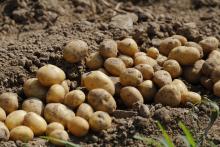Developing new models to predict PCN species presence / absence in Scottish soils

Seed potatoes are small tubers that are used to “seed” the soil and grow new potatoes. Most potatoes grown in the UK originate from Scottish seed, therefore Scottish seed underpins the wider UK potato industry, which is worth an estimated £5 billion p.a. Our potatoes are under threat, however, from potato cyst nematodes (PCN), which are microscopic, soilborne, worms that feed on potato roots. PCN drastically reduce crop yields and quality and are incredibly difficult to control. The main route by which PCN spreads is through the movement of infested soil, which may be transferred with tubers. Current legislation aimed at preventing PCN spread therefore targets seed production, and all land used for seed must be tested and the soil sample declared free from PCN prior to planting. Crops that are grown for consumption or processing, therefore not for further propagation, are not subject to statutory soil testing.
This study will investigate if state-of-the-art machine learning techniques can be used to develop a model for predicting the presence or absence of different PCN species in any potential crop location. This will enable data-driven, species-specific decision-making in policy and practice, and would be particularly useful for prediction in crop locations that are not subject to statutory testing, as well as providing a tool to predict where new infestations are more likely to occur.
Image of Potato by Jai79 from Pixabay
This study will investigate if state-of-the-art machine learning techniques can be used to develop a model for predicting the presence or absence of different PCN species in any potential crop location. This will enable data-driven, species-specific decision-making in policy and practice, and would be particularly useful for prediction in crop locations that are not subject to statutory testing, as well as providing a tool to predict where new infestations are more likely to occur.
Image of Potato by Jai79 from Pixabay
